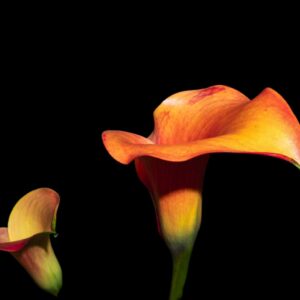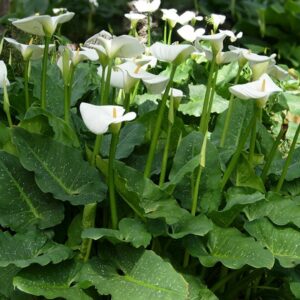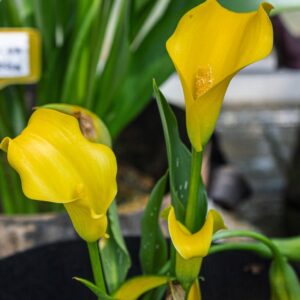Your cart is currently empty!
Wild Calla Lilies: Unveil Nature’s Enchanting Bloom

Introduction
Wild calla lilies, also known as arum lilies, are captivating perennials renowned for their elegant, trumpet-shaped flowers. These enigmatic blooms embellish wetlands, streams, and damp forests around the world, alluring pollinators with their alluring hues and unique structures.
Classification
Family:
Araceae
Genus:
Zantedeschia
Species:
Zantedeschia aethiopica (White calla lily), Z. elliottiana (Yellow calla lily), Z. albomaculata (Spotted calla lily)
Description
Flowers:
Wild calla lilies bear large, showy flowers consisting of a central spadix (male reproductive structure) enclosed by a spathe (petal-like leaf). The spathe can vary in color from pristine white to vibrant yellow or pink, depending on the species.
Leaves:
These plants produce long, arrowhead-shaped leaves that are often spotted or variegated. The leaves emerge from the base of the plant and form a lush, green foliage.
Height:
Wild calla lilies typically reach heights of 1-3 feet (0.3-0.9 meters) when in bloom.
Habitat
Wild calla lilies thrive in moist, shady areas such as marshes, swamps, and along riverbanks. They prefer well-drained soil that is rich in organic matter.
Distribution
Native to South Africa, wild calla lilies have naturalized in several regions around the world, including Europe, Asia, and North America. They are often found in disturbed habitats, such as roadsides and ditches.
Ecological Significance
Wild calla lilies play an important ecological role as a source of nectar and pollen for pollinators, including bees, butterflies, and moths. Their attractive flowers also serve as a visual cue for birds that disperse their seeds.
Toxicity
Caution: All parts of the wild calla lily plant are toxic to humans and animals if ingested. The plant contains calcium oxalate crystals, which can cause irritation to the mouth, throat, and digestive tract.
Cultivation
Wild calla lilies can be cultivated in gardens and containers with proper care. Here are some tips for successful cultivation:
- Light: Provide partial to full shade, especially in hot climates.
- Soil: Plant in well-drained, moisture-retentive soil that is rich in organic matter.
- Water: Water regularly, especially during hot, dry weather. Keep the soil consistently moist but not waterlogged.
- Fertilizer: Apply a balanced liquid fertilizer once a month during the growing season.
- Overwintering: In cold climates, calla lilies should be dug up and stored in a cool, dry place over the winter.
Varieties
Wild calla lilies come in a variety of species and cultivars. Some popular varieties include:
- Zantedeschia aethiopica: White calla lily with large, pure white spathes
- Z. elliottiana: Yellow calla lily with bright yellow spathes
- Z. albomaculata: Spotted calla lily with white spathes spotted with purple
- Z. rehmannii: Pink calla lily with soft pink spathes
- Z. ‘Captain Holgate’: Dwarf calla lily with variegated leaves
Uses
Ornamental:
Wild calla lilies are prized for their ornamental value and are often used in gardens and floral arrangements. Their elegant flowers and glossy foliage add a touch of sophistication to any landscape.
Medicinal:
In traditional medicine, wild calla lily extract has been used for its anti-inflammatory and antiseptic properties. It has also been applied topically to treat skin conditions such as eczema and psoriasis.
Conclusion
Wild calla lilies are captivating blooms that add beauty and ecological value to their environments. With their diverse range of colors and easy cultivation, these versatile plants can enhance both natural and cultivated landscapes. While they possess some medicinal properties, it’s crucial to remember that they are toxic and should not be ingested.








Leave a Reply